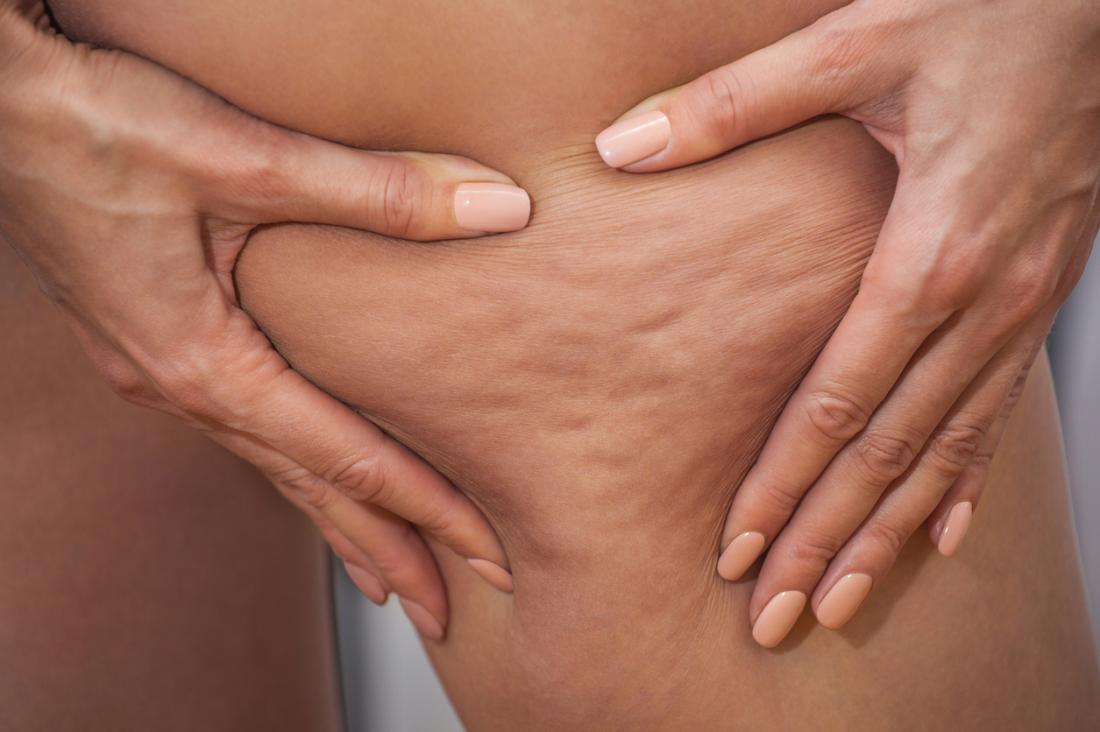Have you noticed any lumpy or uneven skin on your legs, thighs, or hips? These could be signs of cellulite on legs, which occurs when bands of fatty tissue pull the skin covering certain areas of fat downward, creating an uneven surface.
Cellulite is most commonly found on the thighs, abdomen, hips, and breasts. Women are more prone to cellulite than men due to differences in connective tissue, muscle, and fat distribution. Nearly 90% of women may experience cellulite to some degree, and it is typically not harmful.
But what causes cellulite in the first place? And what is cellulite vs. stretch marks on thighs?
Cause of Cellulite
Cellulite is a cosmetic condition characterized by the dimpled or lumpy appearance of the skin, primarily in areas such as the thighs, hips, and buttocks.
It results from the accumulation of fat beneath the skin, which puts pressure on connective tissues and causes the skin to pucker.
Although cellulite is a common concern, it is not a medical condition and does not pose any health risks.
Several factors can contribute to the development of cellulite, including genetics, age, hormonal changes, poor diet, and a sedentary lifestyle.
While there is no known cure for cellulite, there are many treatments available that can help reduce its appearance. This includes massage, topical creams, laser therapy, and other medical procedures.
Furthermore, maintaining a healthy and active lifestyle can help prevent or minimize cellulite development.
Eating a balanced diet, staying hydrated, and engaging in regular physical activity can improve blood flow and reduce the accumulation of fat. Thereby reducing the appearance of cellulite.
In summary, while cellulite may be a cosmetic concern, it is a common condition that affects many people and does not pose any significant health risks. There are various treatments available to help reduce its appearance, but a healthy lifestyle is the most effective way to prevent or minimize its development.
How To Get Rid of Cellulite?
Cellulite is a common occurrence in people of all body types, and it appears as puckered or dimpled skin due to the way fat pushes against the connective tissue. Although it’s natural and cannot be fully eliminated, there are ways to reduce its appearance and improve the overall look of your skin.
When it comes to reducing the appearance of cellulite, cosmetic surgeons have an array of treatments available.
These treatments include deep massaging techniques to plump up the skin, acoustic wave therapy which uses sound waves to break up cellulite, and laser treatments that help thicken the skin.
Liposuction is another option, but it’s important to note that it mainly targets deep fat rather than cellulite specifically.
Mesotherapy involves injecting drugs directly into the cellulite, while subcision breaks up tough bands causing cellulite using a needle.
Topical treatments like creams and lotions containing caffeine or 0.3% retinol, spa treatments, and vacuum-assisted precise tissue release can also temporarily reduce the appearance of cellulite.
Additionally, radiofrequency, ultrasound, infrared light, or radial pulses can be used to heat the skin and help improve the look of cellulite.
Can Regular Physical Activity Reduce The Appearance Of Cellulite?
Exercise can help improve the appearance of cellulite. Regular exercise increases your muscle mass, which flattens cellulite.
It also increases blood flow to certain areas of your body, which speeds up fat loss.
The following activities can help improve the appearance of your cellulite: Running, Cycling, and Resistance training.
Regular physical activity can enhance the appearance of cellulite by increasing muscle mass, which can minimize the appearance of dimpled skin.
Furthermore, exercise can stimulate blood flow to specific areas of the body, promoting fat loss.
Running, cycling, and resistance training are examples of physical activities that can help improve the appearance of cellulite.
Factors That Increase The Risk
Cellulite is a common skin condition that affects women more than men. After puberty, most women develop some degree of cellulite due to their body’s tendency to store fat in the hips, thighs, and buttocks, which are common areas for cellulite to form.
Age-related changes in skin elasticity can also contribute to cellulite. Genetics is a significant risk factor, as the condition tends to run in families.
Even lean individuals can have cellulite, which may become more noticeable with weight gain. Inactivity and pregnancy are other risk factors for developing cellulite.
Conclusion
If you’re looking to reduce the appearance of cellulite, it’s best to start with natural and inexpensive approaches. Incorporating regular exercise and a healthy diet can be effective in minimizing cellulite.
Cellulite refers to pockets of fat that cause a bumpy or dimpled texture on the skin’s surface. It’s typically found in areas such as the buttocks, thighs, and hips.
It’s important to consult with your doctor, plastic surgeon, or dermatologist about your goals and the steps you plan to take.
They can help you determine the most appropriate treatment option, taking into account cost and potential side effects or complications. By discussing your concerns with a medical professional, you can make informed decisions about how to best address cellulite.

